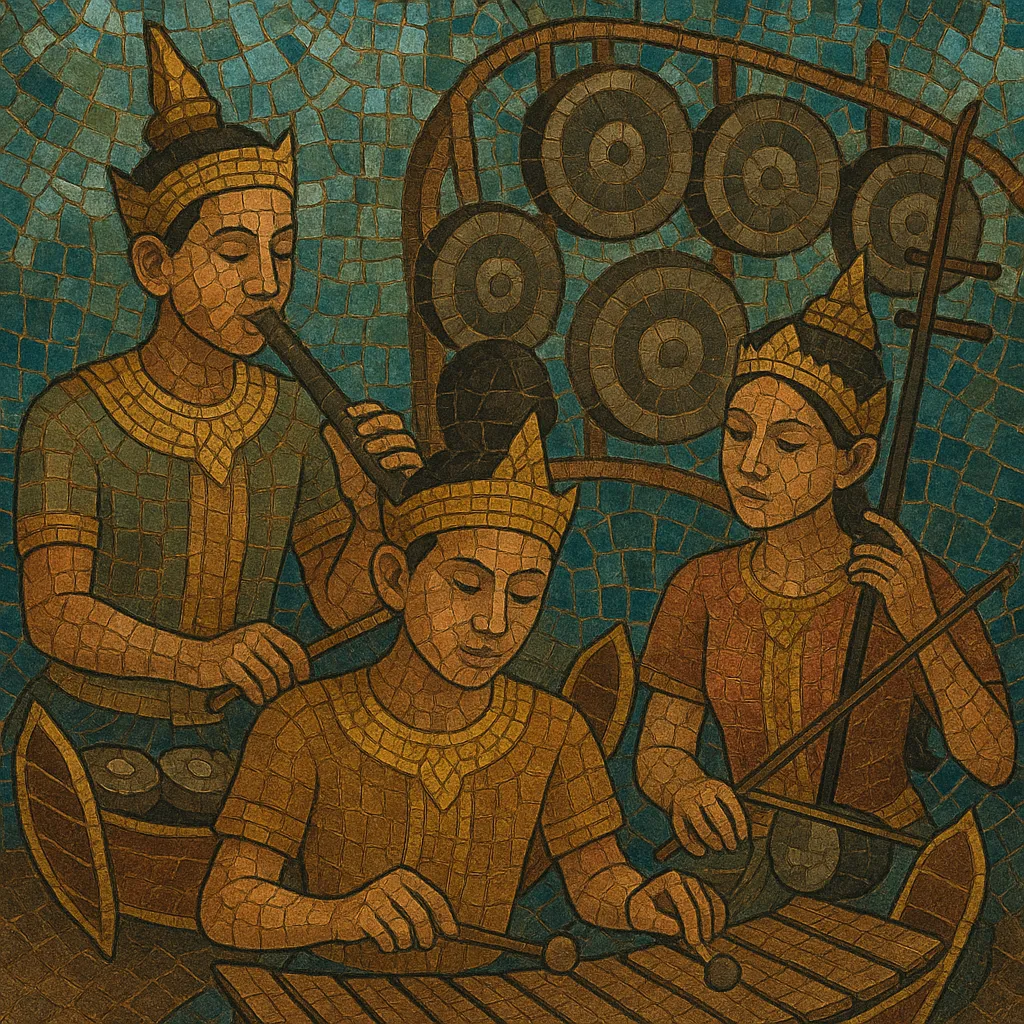Khmer music refers to the traditional and courtly musical practices of Cambodia, spanning ritual, theatrical, and social repertoires. Its sound is defined by layered heterophony, cyclic rhythms marked by small finger cymbals (chhing), and modal melodies carried by oboes, xylophones, gongs, and fiddles.
Core ensembles include the Pinpeat (ceremonial/court and temple music with roneat xylophones, sralai oboe, kong vong gong-circles, skor drums, and chhing), the Mohori (entertainment ensemble with bowed fiddles, dulcimer, flute, plucked lute, and light percussion), and Arak/Phleng Kar (healing and wedding music, respectively, with voice-forward textures and flexible instrumentation). Vocal styles are melismatic and highly ornamented, closely aligned to Khmer poetic prosody, ritual texts, and dance theatre.
The music employs pentatonic and heptatonic modes with characteristic intonation, cyclical time organization, and a leader–chorus texture where a lead instrument or voice guides the ensemble. While deeply rooted in indigenous practice from the Angkor era, Khmer music also reflects centuries of exchange with Indic, Siamese/Thai, Lao, and Chinese traditions.
Khmer music coalesced in the Angkor period (9th–15th centuries), serving royal court rites, temple ceremonies, and classical dance-drama. Reliefs at Angkor Wat depict instruments resembling today’s roneat (xylophones), kong vong (gong-circles), and sralai (quadruple-reed oboe), evidencing a mature orchestral tradition. Buddhist liturgy, Indic aesthetics, and regional exchange shaped the ritual and court soundworlds.
Over time, distinct ensemble families emerged:
• Pinpeat: the ceremonial and theatrical orchestra for royal and religious contexts. • Mohori: a lighter, entertainment-oriented ensemble for salons and public festivities. • Arak/Phleng Kar: healing and wedding repertoires that foreground voice, ritual texts, and flexible accompaniment. These ensembles share modal concepts and heterophonic texture but differ in function, scale use, and timbral balance.The late 19th–mid 20th centuries saw urban and media modernization. Court and temple musicians engaged with new venues and recording, influencing and being echoed by emerging popular forms. A golden era of Cambodian popular song in the 1950s–60s absorbed classical melodic turns and instrumental colors into modern bands and studio orchestras.
The Khmer Rouge period (1975–1979) devastated musical lineages, with many artists and teachers lost. Beginning in the 1980s, surviving masters, communities, and diasporas led intensive revival, documentation, and pedagogy. UNESCO recognitions tied to Cambodian performing arts (e.g., Royal Ballet, Sbek Thom shadow theatre, Lakhon Khol, Chapei Dang Veng) amplified preservation and transmission of the musical components.
Today, Khmer music thrives across temples, festivals, conservatories, and stages worldwide. Traditional ensembles coexist with hybrid projects and pop/hip-hop fusions, while educational programs and archives reinforce intergenerational transmission. The core aesthetics—heterophony, cyclical rhythm, modal melody, and ornamented vocalism—remain the anchor of the tradition.


